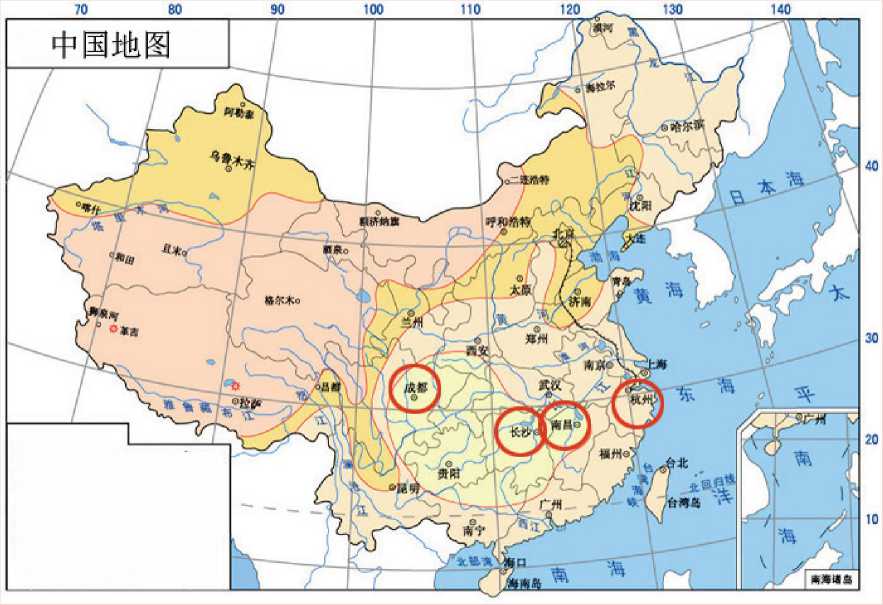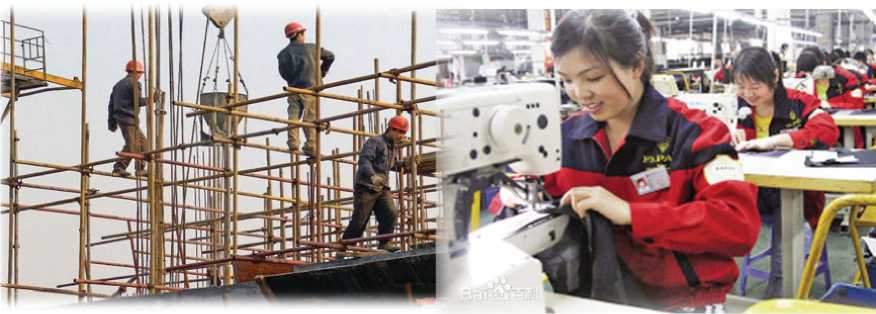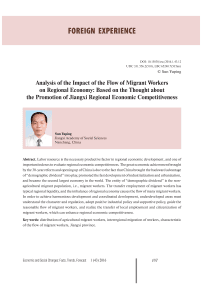Analysis of the impact of the flow of migrant workers on regional economy: based on the thought about the promotion of Jiangxi regional economic competitiveness
Автор: Sun Yuping
Журнал: Economic and Social Changes: Facts, Trends, Forecast @volnc-esc-en
Рубрика: Foreign experience
Статья в выпуске: 1 (43) т.9, 2016 года.
Бесплатный доступ
Labor resource is the necessary productive factor in regional economic development, and one of important indexes to evaluate regional economic competitiveness. The great economic achievement brought by the 30-year reform and opening up of China is due to the fact that China brought the backward advantage of “demographic dividend” into play, promoted the fast development of industrialization and urbanization, and became the second largest economy in the world. The entity of “demographic dividend” is the non-agricultural migrant population, i.e., migrant workers. The transfer employment of migrant workers has typical regional liquidity, and the imbalance of regional economy causes the flow of many migrant workers. In order to achieve harmonious development and coordinated development, underdeveloped areas must understand the character and regulation, adopt positive industrial policy and supportive policy, guide the reasonable flow of migrant workers, and realize the transfer of local employment and citizenization of migrant workers, which can enhance regional economic competitiveness.
Distribution of agricultural migrant workers, interregional migration of workers, characteristic of the flow of migrant workers, jiangxi province
Короткий адрес: https://sciup.org/147223800
IDR: 147223800 | УДК: 331.556.2(510) | DOI: 10.15838/esc/2016.1.43.12
Текст научной статьи Analysis of the impact of the flow of migrant workers on regional economy: based on the thought about the promotion of Jiangxi regional economic competitiveness
Labor resource is the necessary productive factor in regional economic development, and one of important indexes to evaluate regional economy competitiveness. The great economic achievement brought by 30-year reform and opening up of China can be contributed to that China has brought the backward advantage of “demographic dividend” into play, promoted the fast development of industrialization and urbanization, and become the second largest economic entity in the world. The entity of “demographic dividend” is the nonagricultural migrant population, i.e., migrant workers. The transfer employment of migrant workers has typical regional liquidity, and the imbalance of regional economy causes the flow of many migrant workers. In order to achieve harmonious development and coordinative development, underdeveloped areas must understand the character and regulation, adopt positive industrial policy and supportive policy, guide reasonable flow of migrant workers, and realize the transfer of local employment and citizenization of migrant workers, which can enhance regional economic competitiveness.
-
1. Development trend and flow status of migrant workers
-
2. Characteristics of cross-regional flow of migrant workers
-
3. Flow of Jiangxi migrant workers and its impact on economic development
When studying population flow of the process of urbanization, American economist Louis found that the rural labor will definitely flow to urban areas if the urban salary was 30% higher than the real salary of rural residence. Price scissor of industrial and agricultural products has existed for a long time since new China was founded, and it has made a comparatively big salary difference between urban residence and rural residence. The salary difference between urban residence and rural residence was as high as 2.36:1 in year 1978. Due to the limitation of dual economic structure and household management system dividing urban and rural areas, the peasants occupying 80% of population were limited in the land. With reform and opening up, global integration of Chinese economy moved rapidly, and urbanization, industrialization and agriculture modernization developed fast, which made agricultural transfer population flow into township enterprise, industrial park, urban and economic developed areas.
Surplus labor continuously released from traditional agricultural departments – peasant, is the important resource of 30-year fast economic growth and development, and “demographic dividends” promotes prosperity of export-oriented economy based on international market. According to the statistics of China’s Floating Population Development Report-2013 issued by National Health and Family Planning Committee, China’s floating population increased from 6 million to 236 million from 1979 to 2012. The statistics of migrant worker monitoring survey from National Bureau of Statistics indicated that population of migrant workers reached 269 million, and outgoing migrant workers were 166million.
Affected by regional resource and opening degree of industry, the flow of Chinese migrant workers has an unbalanced trend. Analyzing from basic status of migrant workers’ flow after reform and opening up of China, we can find one obvious characteristic that eastern developed areas effect middle and western underdeveloped areas. The rapidly developed export-oriented manufacturing industry in eastern area has attracted a lot of surplus labors of middle and western areas to transfer to eastern area, which has become an important area to take in surplus population of China. Regional advantage and industrial first-mover advantage of Yangtze River Delta and Pearl River Delta were made good use by Zhejiang province and Guangdong province in eastern area which became preferred regions to take in migrant works in China.
According to the statistics issued by National Bureau of Statistics in 2012, 65% of outside migrant workers chose to work in eastern area, 17.9% in middle area, and 17.1% in western area.
Taking Zhejiang for an example, migrant workers to Zhejiang province in 2010 were 11,823,900, among which over one million were transferred from 5 provinces, as shown in the table below (Table 1) .
While the outgoing migrant workers of Zhejiang province were only 1.85 million in the same year, the net inflow of labor resource was 5.4 times. Migrant workers play a very important role in rapid development of economy in Zhejiang province.
Current situation of Jiangxi migrant workers
As a big agricultural province, Jiangxi has a large ratio of rural population as big as 27,234,000 in 1978, which occupies 85.56% (The whole country is 80.08%) of total population. After reform and opening up, agricultural migrant population has experienced the first period of flowing to township enterprise, and the historical process of transferring to industrial park, urban and developed coastal areas. After financial crisis in 2008, there were a lot of migrant workers returning home. But in a short time, many of them went out to work. Jiangxi had 7.563 million migrant workers which occupied 23.8% of labor population with year-on-year growth of 226,000 agricultural transfer labor forces, and 70% of migrant workers went to work in other provinces.
Table 1. Main regional distribution of migrant workers to Zhejiang in 2010 (10,000 people)
|
Total population of Migrant workers to Zhejiang |
1182.39 |
|
Including: |
|
|
Anhui |
228.52 |
|
Jiangxi |
152.98 |
|
Guizhou |
149.92 |
|
Sichuan |
124.05 |
|
Henan |
122.42 |
|
Source: Data of the sixth national census in 2010. |
|
We can see from Table 2 that the ratio of Jiangxi outgoing migrant workers reduced gradually, and the backflow and local employment willingness were obvious, but the total population of migrant workers that went to work in other provinces was still big.
Table 3 reflected that middle areas are still main areas for agricultural transfer population, while employment ratio inside Jiangxi, Hunan and Anhui provinces were comparatively low, which became the main reason to limit industrialization and urbanization of the three provinces.
Effect on regional economic com-petitiveness
The outgoing phenomenon of local migrant workers will cause several major problems:
-
– first, local industrial development lacks efficient labor supply;
-
– second, it is hard to promote urbanization;
-
– third, polarization effect will come into being, and the following work and exceeding strategy of regional economic development will be passive;
-
– fourth, development of private economy will be comparatively lagged behind.
As for the labor supply, Jiangxi Academy of Social Sciences once investigated three industrial parks in Nanchang city in 2012, finding the rate of migrant workers is 73.8% of total employees in the parks, and they had been the main force of Jiangxi industrialization (Table 4) . But the critical situation is that it’s normal for three parks to lack labor forces. The rate of shortage of labor in Nanchang Hi-Tech Industrial Development Zone was 15–20%, Nanchang Economic and Technological Zone was around 15%, and Jiangxi Sanghai Economic Technology Zone was even more than 50%. It’s hard for enterprises in the parks to employ workers locally. They
Table 2. Employment of agricultural transfer population of Jiangxi in 2010–2012
|
Employment Year |
Employment outside the province (10,000 people) |
Employment inside the province (10,000 people) |
Total population (10,000 people) |
Ratio (%) |
|
2010 |
518.8 |
199.5 |
718.3 |
72:28 |
|
2011 |
512.8 |
220.9 |
733.7 |
70:30 |
|
2012 |
522.7 |
233.6 |
756.3 |
69:31 |
Table 3. Employment of agricultural transfer population of middle six provinces in 2012
|
Jiangxi |
Henan |
Shanxi |
Hubei |
Hunan |
Anhui |
|
|
Population (10,000 people) |
756.3 |
2458 |
470 |
1076.3 |
1470.8 |
1449 |
|
Employment ratio inside the province (%) |
30.9 |
51.6 |
74 |
53.5 |
30.5 |
26 |
|
Source: Statistics yearbook of every middle province. |
||||||
Table 4. Labor shortage in 3 industrial parks of Nanchang in 2012 (%)
|
Development District |
Rate of labor shortage |
|
Nanchang Hi-Tech Industrial Development Zone |
15-20 |
|
Nanchang Economic and Technological Development Zone |
15 |
|
Jiangxi Sanghai Economic Technology Zone |
50 |
Figure 1. Location of Four Provinces

must hire people from the western places like Guizhou and Yunnan. Therefore, many investment attraction projects choose to quit Jiangxi because the labor supply lacks security.
Table 5 is about comparisons of 4 provinces including Zhejiang of eastern area, Jiangxi and Hunan of middle area, Sichuan of western area at the same latitude (Figure 1) . Jiangxi,
Hunan and Sichuan are big provinces to output migrant workers, and their economic strengths lag behind Zhejiang of eastern area and are lower than the national average level. In order to promote regional economic competitiveness, it’s necessary to guide the reasonable flow of migrant workers and strengthen the attraction of local employment.
Table 5. Main economic indexes of Zhejiang, Hunan, Sichuan, Jiangxi in 2012
|
Index Area |
GDP (100 million yuan) |
GDP per person (yuan) |
Industrial added value (100 million yuan) |
Three times industrial structure |
Urbanization rate (%) |
|
Zhejiang |
34665.3 |
63266 |
15338.0 |
4.8:50.0:45.2 |
63.2 |
|
Hunan |
22154.2 |
33480 |
9140.0 |
13.6:47.4:39.0 |
46.7 |
|
Sichuan |
23849.8 |
29579 |
10800.5 |
13.8:52.8:33.4 |
43.5 |
|
Jiangxi |
12948.5 |
28799 |
5854.6 |
11.7:53.8:34.5 |
47.5 |
|
China |
519322.0 |
38354 |
199860.0 |
10.1:45.3:44.6 |
52.6 |
Policy recommendations
-
(1) Undertake gradient transfer of coastal industry
In order to take in local labor for employment, Jiangxi needs to seize the strategic opportunity of eastern coastal industry’s transformation and upgrading, take comparative advantages to the full, strengthen industrial cooperation among areas, attract investment positively, and develop export processing industry and manufacturing industry suitable for mid-term features of industrialization and local resource conditions.
At the same time, Jiangxi should make full use of the advantage of local ecological resources to promote the development of industries such as ecological agriculture, tourism and service, and green environmental protection, which cannot only expand employment market of labor force, but also achieve sustainable development.
-
(2) Improve development level of open economy
One of the main reasons for underdeveloped economy of Jiangxi is that its openness is not enough. Strengthening development of open economy is an inevitable choice for Jiangxi to realize the exceeding in economy and narrowing the gap with developed areas. Open economy will definitely create good external conditions for the return of migrant workers, and attract local migrant workers to go back to work in hometown.
Actions will be taken:
-
1. Pay attention to connection and cooperation of industries, and extend the production space and market space.
-
2. Enlarge the openness to foreign enterprises and central enterprises, focus on bringing in transnational enterprises which can make global effects, and promote competitiveness and power of industries.
-
3. Pay attention to development of strategic new industries such as new energy, new material, equipment manufacturing and biological medicine, develop domestic and international market actively, make good use of technical renovation to realize transformation and upgrading of traditional competitive industry, and strengthen competitiveness of regional industry.
-
(3 ) Enhance group development of reginal economic entity
Low level competition era of industry has changed silently. City, as an important platform of industrial competition, is playing a more and more important role. Economic integration and industrial group development make modern urban economy choose the way of group to enhance overall regional economic strength and competitiveness. Jingjinji, Pearl River Delta and Yangtze River Delta economic districts are all typical cases of urban group development and strong rise.
Jiangxi is requested to use strategic commanding point of “integration of Nanchang and Jiujiang” to achieve breakthrough of urban group strategy, and use policy coupling effect of urban group construction of Yangtze River economic district and the middle reach of Yangtze River to achieve new breakthrough of urban economic development.
The promotion of urban development level will inevitably attract the backflow of outgoing migrant workers, which will provide constant labor support for the development of urban economy and industry.
-
(4 ) Guide migrant workers for local transfer and citizenization
Guiding rural surplus labor for local transfer is the key to secure industrial development and strengthen urbanization.
In order to let migrant workers get employed smoothly, the migrant workers must integrate to cities and become real citizens and enjoy the same social and economic rights of original citizens.
Breaking the limitation of urban and rural household system is just the first step. More importantly, the migrant workers in the city should possess the ability to work in the city and enjoy complete social security. Therefore, it’s the highest priority to raise employment ability and quality of migrant workers, and government has responsibilities to provide relevant social services.
-
(5 ) Encourage returned backflow migrant workers to start business to become rich
Government is suggested to create good environment and conditions of starting business and realizing their dreams for the migrant workers who have dreams after they return. Outgoing work not only makes

migrant workers accumulate the capitals to start business, and also let them learn how to develop industry and manage an enterprise. As for private economic development, government needs to make policy guidance and loosen the limitation of private investment capital through making industrial entry list. Establishing power list can clarify the limit of government, build uncorrupted and efficient government and create flexible environment of market economic development.
It’s time for Jiangxi economy to take off when private economy becomes prosperous. Entrepreneurship will definitely realize the dream to raise Jiangxi.


